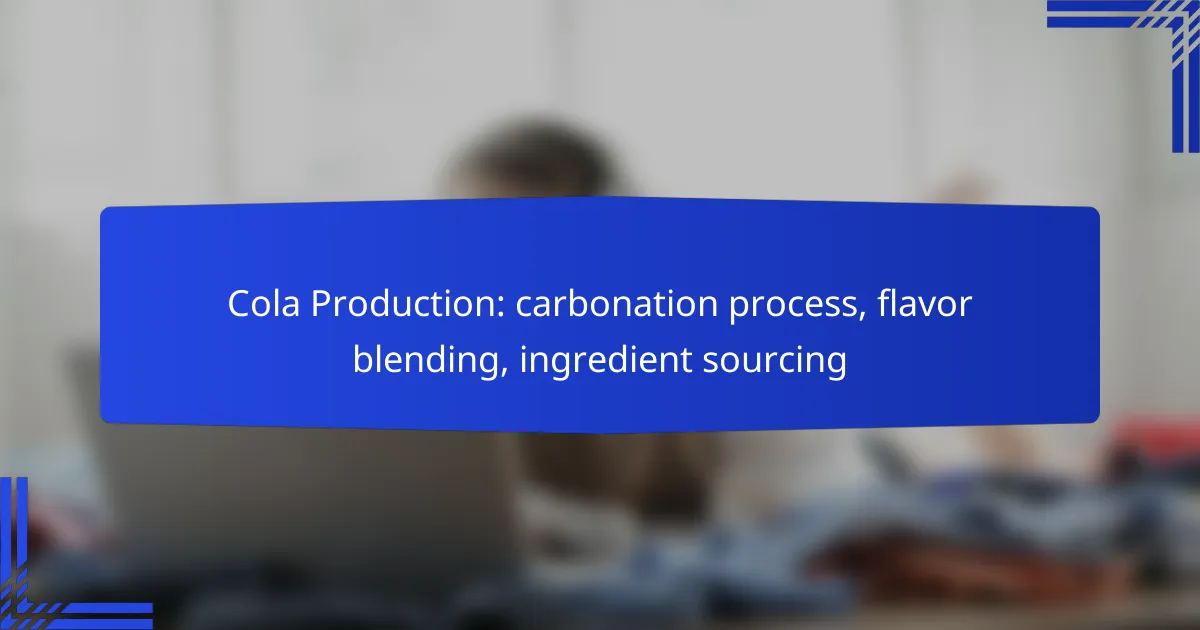Cola production involves a meticulous carbonation process where carbon dioxide (CO2) is injected into the beverage, creating its signature fizz and enhancing freshness. The flavor is crafted through a blend of key ingredients, including caffeine, natural extracts, and sweeteners, which together deliver the unique taste that cola lovers enjoy. Ingredient sourcing for cola often combines local and global suppliers, ensuring quality and consistency in flavor while adhering to industry standards.

How is carbonation achieved in cola production?
Carbonation in cola production is primarily achieved through the injection of carbon dioxide (CO2) into the beverage, creating the characteristic fizz. This process not only enhances the drink’s sensory experience but also helps preserve its freshness and flavor.
Carbon dioxide injection
Carbon dioxide injection is the most common method for achieving carbonation in cola. During this process, CO2 gas is dissolved into the liquid under high pressure, allowing it to mix thoroughly. Once the pressure is released, the gas forms bubbles, creating the effervescence that consumers enjoy.
Typically, the CO2 levels in cola range from 2.5 to 3.5 volumes, which means that the gas volume is 2.5 to 3.5 times greater than the liquid volume. This level of carbonation is crucial for achieving the right mouthfeel and taste balance.
Natural fermentation methods
Natural fermentation methods involve using yeast to produce carbon dioxide as a byproduct of sugar metabolism. This traditional approach can impart unique flavors to the cola, but it requires careful monitoring to ensure consistent carbonation levels.
While less common in commercial production, some craft cola makers utilize this technique to create distinctive beverages. Fermentation can take several days to weeks, depending on the desired flavor profile and carbonation level.
Pressure and temperature control
Maintaining proper pressure and temperature is essential for effective carbonation in cola production. Higher pressures increase the solubility of CO2 in the liquid, while lower temperatures help retain the gas longer. Typically, carbonation occurs at temperatures around 0 to 5 degrees Celsius.
Producers must carefully manage these conditions to avoid over-carbonation or flat beverages. Regular monitoring and adjustments during the carbonation process can help achieve the ideal balance for the final product.

What are the key ingredients in cola flavor blending?
The key ingredients in cola flavor blending include caffeine, natural flavor extracts, and sweeteners. These components work together to create the distinctive taste and stimulating effect that cola beverages are known for.
Caffeine sources
Caffeine is a crucial ingredient in cola, providing the characteristic energy boost. Common sources include kola nuts, which are traditional, and synthetic caffeine, which is often used for consistency and cost-effectiveness.
When selecting caffeine sources, consider the desired flavor profile and regulatory standards. For instance, synthetic caffeine can be more easily controlled for dosage, while natural sources may appeal to consumers seeking organic options.
Natural flavor extracts
Natural flavor extracts are essential for achieving the unique taste of cola. These typically include extracts from spices, citrus oils, and vanilla, which contribute to the complex flavor profile.
When blending flavors, balance is key. Too much of one extract can overpower others, so it’s advisable to start with small quantities and adjust gradually. Additionally, sourcing high-quality extracts can significantly enhance the final product.
Sweeteners used
Sweeteners play a vital role in cola production, with options ranging from sugar and high-fructose corn syrup to artificial sweeteners like aspartame and stevia. The choice of sweetener impacts not only flavor but also calorie content and consumer preferences.
For a traditional cola flavor, cane sugar is often preferred, while low-calorie options may use a blend of artificial sweeteners. Be mindful of the target market’s preferences and any health regulations regarding sweetener use in your region.

How are ingredients sourced for cola production in Australia?
In Australia, sourcing ingredients for cola production involves a combination of local and global suppliers, ensuring quality and flavor consistency. Key ingredients like sugar and flavorings are procured from both domestic and international sources, adhering to industry standards and regulations.
Local sugar suppliers
Australian cola producers primarily source sugar from local cane and beet sugar suppliers. This practice supports the domestic economy and reduces transportation costs. Local sugar is often preferred for its freshness and lower environmental impact, with major suppliers located in Queensland and New South Wales.
Producers typically engage with suppliers who meet Australian food safety standards, ensuring that the sugar used is of high quality and suitable for beverage production. This local sourcing can also enhance brand image by promoting sustainability and community support.
Global flavor manufacturers
Flavoring agents for cola are often sourced from global manufacturers specializing in beverage ingredients. These suppliers provide a wide range of flavors, including natural and synthetic options, to create the distinct taste profile of cola. Companies may work with flavor houses in Europe, North America, and Asia to access innovative flavor technologies.
When selecting global suppliers, Australian producers consider factors such as consistency, cost, and compliance with local regulations. Collaborating with established flavor manufacturers helps ensure that the final product meets consumer expectations for taste and quality.
Ethical sourcing practices
Ethical sourcing practices are increasingly important in the cola production industry. Australian producers are focusing on sourcing ingredients from suppliers who adhere to fair labor practices and sustainable farming methods. This commitment not only enhances brand reputation but also aligns with consumer demand for socially responsible products.
Producers often conduct audits and require certifications from suppliers to verify ethical practices. By prioritizing ethical sourcing, companies can contribute to positive social and environmental impacts while maintaining high standards for their cola products.

What are the challenges in cola production?
Cola production faces several challenges, including maintaining ingredient consistency, adhering to regulatory compliance, and minimizing environmental impact. Each of these factors plays a crucial role in ensuring the quality and sustainability of the final product.
Ingredient consistency
Ensuring ingredient consistency is vital for cola manufacturers to deliver a uniform taste across batches. Variations in raw materials, such as sugar or flavor extracts, can lead to noticeable differences in flavor and quality.
To maintain consistency, producers often rely on strict quality control measures and standardized sourcing practices. This may involve using specific suppliers or blending techniques to achieve the desired flavor profile consistently.
Regulatory compliance
Cola production must comply with various regulations that govern food and beverage safety. These regulations can vary significantly by country and may include guidelines on ingredient labeling, health claims, and safety standards.
Manufacturers need to stay updated on local regulations, such as the FDA in the United States or EFSA in Europe, to ensure their products meet legal requirements. Non-compliance can lead to fines, product recalls, or damage to brand reputation.
Environmental impact
The environmental impact of cola production is a growing concern, with issues such as water usage, carbon emissions, and plastic waste coming under scrutiny. Efficient resource management is essential to minimize these impacts.
Companies are increasingly adopting sustainable practices, such as using recycled materials for packaging and optimizing production processes to reduce energy consumption. Engaging in corporate social responsibility initiatives can also enhance a brand’s reputation while addressing environmental challenges.

What are the trends in cola carbonation technology?
Current trends in cola carbonation technology focus on enhancing efficiency, improving flavor retention, and reducing environmental impact. Innovations are emerging in equipment design and ingredient sourcing, leading to better carbonation processes and overall product quality.
Advancements in carbonation equipment
Modern carbonation equipment has seen significant improvements, particularly in precision and energy efficiency. New systems utilize advanced sensors and automation to monitor and adjust carbonation levels in real-time, ensuring consistent quality across batches.
Additionally, many manufacturers are adopting compact carbonation units that require less space and energy, making them ideal for small-scale producers. These units can achieve optimal carbonation levels quickly, often within minutes, which helps maintain the freshness of the cola.
Innovations in flavor preservation
Flavor preservation is becoming increasingly important in cola production, with new techniques being developed to maintain taste integrity during carbonation. One effective method involves using specialized gas mixtures that enhance flavor compounds while preventing oxidation.
Moreover, some companies are exploring the use of natural preservatives derived from plant extracts, which can extend shelf life without compromising flavor. This trend aligns with consumer preferences for cleaner labels and more natural ingredients, making it a practical consideration for cola producers.

How does cola production impact the Australian beverage market?
Cola production significantly influences the Australian beverage market by shaping consumer choices and driving competition among brands. The unique carbonation process, flavor blending techniques, and ingredient sourcing strategies play crucial roles in determining market dynamics and consumer preferences.
Market share analysis
The Australian cola market is dominated by a few key players, with major brands holding substantial shares. These brands often compete on factors such as taste, pricing, and marketing strategies, which can lead to shifts in market share over time. For instance, local brands may capture niche markets by emphasizing unique flavors or healthier ingredients.
Market trends indicate that cola beverages are facing competition from alternative drinks, including flavored waters and energy drinks. This shift has prompted cola producers to innovate and diversify their product lines to maintain relevance and appeal to health-conscious consumers.
Consumer preferences
Australian consumers tend to favor cola products that offer a balance of taste and perceived health benefits. Many prefer options with reduced sugar content or natural ingredients, reflecting a growing trend towards healthier choices. Brands that successfully blend traditional cola flavors with modern health trends often see increased consumer loyalty.
Additionally, packaging and branding play a significant role in consumer preferences. Eco-friendly packaging and transparent ingredient sourcing can enhance brand appeal, particularly among younger demographics who prioritize sustainability. Companies that adapt to these preferences can strengthen their market position and attract a broader customer base.
